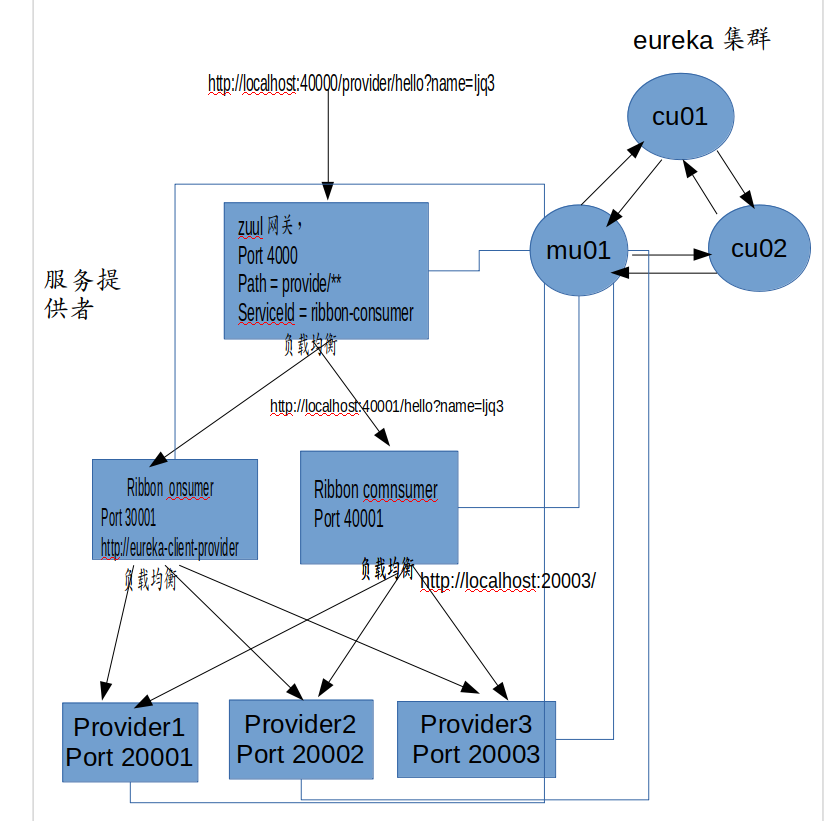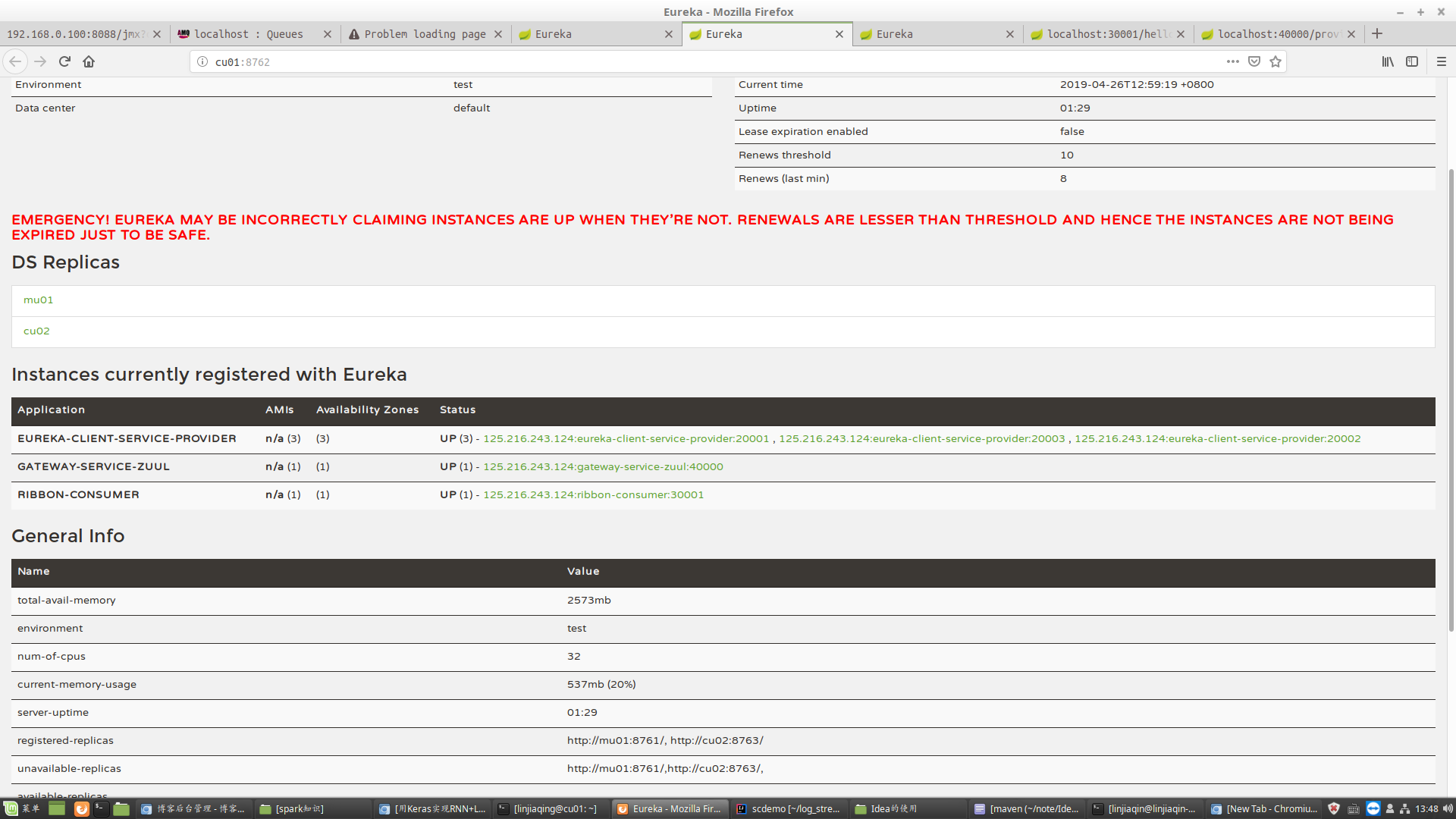SpringCloud分布式微服务搭建(二)
这个例子主要是将zuul和eureka结合起来使用,zuul作为反向代理,同时起到负载均衡的作用,同时网关后面的消费者也作为服务提供者,同时提供负载均衡。
一.API网关(摘自百度)
API网关是一个服务器,是系统的唯一入口。从面向对象设计的角度看,它与外观模式类似。API网关封装了系统内部架构,为每个客户端提供一个定制的API。它可能还具有其它职责,如身份验证、监控、负载均衡、缓存、请求分片与管理、静态响应处理。
API网关方式的核心要点是,所有的客户端和消费端都通过统一的网关接入微服务,在网关层处理所有的非业务功能。通常,网关也是提供REST/HTTP的访问API。服务端通过API-GW注册和管理服务。
二. 整体架构

(1)http://localhost:40000/provider/hello?name=ljq3经过zuul网关之后,由于zuul对路径映射
zuul.routes.api-a.path=/provider/**
zuul.routes.api-a.serviceId=ribbon-consumer
(2)把provider映射到ribbon-cunsumer这个服务上,zuul利用负载均衡的方式选一个服务地址,然后将路径替换,得到
http://localhost:40001/hello?name=ljq3
(3)ribbon-consummer再利用ribbon负载均衡选择一个provider,但是因为我在代码中只把地址传递,而没有传递参数,所以得到的url是
http://localhost:20003/
(4)github地址:https://github.com/linjiaqin/scdemo
三. zuul代码结构
这里把zuul的服务作为一个服务提供者去注册到eureka中,要使用这个注解表名是一个服务提供者@EnableEurekaClient
1.引导类
package com.ljq;
import org.slf4j.Logger;
import org.slf4j.LoggerFactory;
import org.springframework.boot.SpringApplication;
import org.springframework.boot.autoconfigure.SpringBootApplication;
import org.springframework.cloud.netflix.eureka.EnableEurekaClient;
import org.springframework.cloud.netflix.zuul.EnableZuulProxy;
import org.springframework.context.annotation.Bean;
@EnableZuulProxy
@SpringBootApplication
@EnableEurekaClient
//把zuul作为服务提供者到eureka注册
public class GatewayApplication {
private static final Logger LOGGER = LoggerFactory.getLogger(GatewayApplication.class);
GatewayApplication(){
LOGGER.info("app init");
}
public static void main(String[] args) {
LOGGER.info("app start");
SpringApplication.run(GatewayApplication.class, args);
}
}
2.配置文件
这里把的路径匹配规则是当访问的符合provider这个路径时,自动映射到serviceId上,去eureka找到serviceID的所有可用地址,负载均衡选取一个后替换成这个地址
spring.application.name=gateway-service-zuul server.port=40000 eureka.client.serviceUrl.defaultZone=http://mu01:8761/eureka,http://cu01:8762/eureka,http://cu02:8763/eureka zuul.routes.api-a.path=/provider/** zuul.routes.api-a.serviceId=eureka-client-service-provider
3. beanconfig
package com.ljq; import org.slf4j.Logger; import org.slf4j.LoggerFactory; import org.springframework.context.annotation.Bean; import org.springframework.context.annotation.Configuration; import org.springframework.stereotype.Service; @Service public class MyBaenConfig { private static final Logger LOGGER = LoggerFactory.getLogger(MyBaenConfig.class); MyBaenConfig(){ LOGGER.info("service init"); } @Bean public MyFilter myFilter() { LOGGER.info("bean init"); return new MyFilter(); } }
4. zuul的核心filter类,用来过滤请求
package com.ljq; import com.netflix.zuul.ZuulFilter; import com.netflix.zuul.context.RequestContext; import org.apache.commons.lang.StringUtils; import org.slf4j.Logger; import org.slf4j.LoggerFactory; import javax.servlet.http.HttpServletRequest; public class MyFilter extends ZuulFilter { private final Logger LOGGER = LoggerFactory.getLogger(MyFilter.class); MyFilter(){ LOGGER.info("filter init"); } @Override public String filterType() { return "pre"; // 可以在请求被路由之前调用 } @Override public int filterOrder() { return 0; // filter执行顺序,通过数字指定 ,优先级为0,数字越大,优先级越低 } @Override public boolean shouldFilter() { return true;// 是否执行该过滤器,此处为true,说明需要过滤 } @Override public Object run() { RequestContext ctx = RequestContext.getCurrentContext(); HttpServletRequest request = ctx.getRequest(); LOGGER.info("--->>> MyFilter {},{}", request.getMethod(), request.getRequestURL().toString()); String token = request.getParameter("name");// 获取请求的参数 if (StringUtils.isNotBlank(token)) { ctx.setSendZuulResponse(true); //对请求进行路由 ctx.setResponseStatusCode(200); ctx.set("isSuccess", true); return null; } else { ctx.setSendZuulResponse(false); //不对其进行路由 ctx.setResponseStatusCode(400); ctx.setResponseBody("parameter name is empty"); ctx.set("isSuccess", false); return null; } } }
5.mvn spring-boot:run起来之后,就可以看到网关服务在eureka上注册了
curl http://localhost:40000/provider 可以看到负载均衡的效果

6.网关的默认路由规则
但是如果后端服务多达十几个的时候,每一个都这样配置也挺麻烦的,spring cloud zuul已经帮我们做了默认配置。
默认情况下,Zuul会代理所有注册到Eureka Server的微服务,
并且Zuul的路由规则如下:http://ZUUL_HOST:ZUUL_PORT/微服务在Eureka上的serviceId/**会被转发到serviceId对应的微服务。
二 .Ribbon Consumer
这里的consummer不仅是服务消费者去后面拿取provider的内容,同时也作为一个服务提供者对外提供服务
1.引导类
@SpringBootApplication @EnableDiscoveryClient @EnableEurekaClient public class ConsumerApplication { public static void main(String[] args) { SpringApplication.run(ConsumerApplication.class, args); } }
2.beanconfig类
package com.ljq; import org.slf4j.Logger; import org.slf4j.LoggerFactory; import org.springframework.cloud.client.loadbalancer.LoadBalanced; import org.springframework.context.annotation.Bean; import org.springframework.context.annotation.Configuration; import org.springframework.web.client.RestTemplate; @Configuration public class ljqConfig { private static final Logger logger = LoggerFactory.getLogger(ljqConfig.class); ljqConfig(){ logger.info("config init"); } @Bean @LoadBalanced public RestTemplate restTemplate(){ logger.info("restTemplate function"); return new RestTemplate(); } }
3.controller
package com.ljq; import org.slf4j.Logger; import org.slf4j.LoggerFactory; import org.springframework.beans.factory.annotation.Autowired; import org.springframework.web.bind.annotation.GetMapping; import org.springframework.web.bind.annotation.RestController; import org.springframework.web.client.RestTemplate; import javax.servlet.http.HttpServletRequest; @RestController public class ljqController { private static final Logger logger = LoggerFactory.getLogger(ljqController.class); ljqController(){ logger.info("controller init"); } @Autowired private RestTemplate restTemplate; //这里不写eureka的注册中心,而是写服务提供者的应用名 @GetMapping(value = "/hello") public String hello(HttpServletRequest request){ logger.info("hello function"); logger.info(request.getPathInfo()); logger.info("--->>> consumer contorller {},{}", request.getMethod(), request.getRequestURL().toString()); String token = request.getParameter("name");// 获取请求的参数 logger.info(token); return restTemplate.getForEntity("http://eureka-client-service-provider/", String.class).getBody(); } }
配置与上篇文章一致
spring.application.name=ribbon-consumer server.port=30001 eureka.client.serviceUrl.defaultZone=http://mu01:8761/eureka,http://cu01:8762/eureka,http://cu02:8763/eureka
springboot的执行顺序
注解
三. provider
代码与上篇文章基本一直
import org.slf4j.Logger; import org.slf4j.LoggerFactory; import org.springframework.beans.factory.annotation.Value; import org.springframework.web.bind.annotation.RequestMapping; import org.springframework.web.bind.annotation.RestController; import javax.servlet.http.HttpServletRequest; @RestController public class ljqController { private final Logger logger = LoggerFactory.getLogger(ljqController.class); @Value("${server.port}") String port; @RequestMapping("/") public String home(HttpServletRequest request){ logger.info(request.getPathInfo()); logger.info("--->>> consumer contorller {},{}", request.getMethod(), request.getRequestURL().toString()); String token = request.getParameter("name");// 获取请求的参数 logger.info(token); return "Hello world, port is:" + port; } }
一键启动脚本
#首先开启eureka,上篇文章中我们把eureka放在集群上,并单独写了一个脚本了,这里不在赘述 #然后开启zuul cd /home/linjiaqin/log_stream_platform/source/scdemo/gateway; nohup mvn spring-boot:run > /dev/null 2>&1 & #开两个ribbon-consumer cd /home/linjiaqin/log_stream_platform/source/scdemo/consumer nohup mvn spring-boot:run -Dserver.port=30001 > /dev/null 2>&1 & nohup mvn spring-boot:run -Dserver.port=30002 > /dev/null 2>&1 & #开启三个provider cd /home/linjiaqin/log_stream_platform/source/scdemo/provider nohup mvn spring-boot:run -Dserver.port=20001 > /dev/null 2>&1 & nohup mvn spring-boot:run -Dserver.port=20002 > /dev/null 2>&1 & nohup mvn spring-boot:run -Dserver.port=20003 > /dev/null 2>&1 &
测试结果
linjiaqin@linjiaqin-computer:~$ curl http://localhost:40000/provider/hello?name=ljq2 Hello world, port is:20003
linjiaqin@linjiaqin-computer:~$ curl http://localhost:40000/provider/hello?name=ljq3 Hello world, port is:20003
linjiaqin@linjiaqin-computer:~$ curl http://localhost:40000/provider/hello?name=ljq4 Hello world, port is:20003
linjiaqin@linjiaqin-computer:~$ curl http://localhost:40000/provider/hello?name=ljq5 Hello world, port is:20002
linjiaqin@linjiaqin-computer:~$ curl http://localhost:40000/provider/hello?name=ljq6 Hello world, port is:20002




 浙公网安备 33010602011771号
浙公网安备 33010602011771号